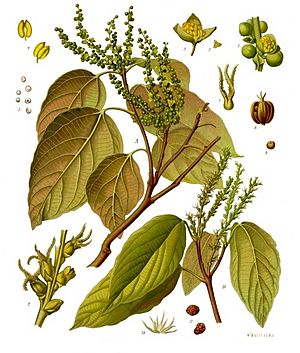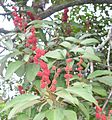Mallotus philippensis facts for kids
Quick facts for kids Mallotus philippensis |
|
|---|---|
 |
|
| Scientific classification | |
| Genus: |
Mallotus (plant)
|
| Species: |
philippensis
|
| Synonyms | |
The Mallotus philippensis is a fascinating plant from the spurge family. People often call it the kamala tree, red kamala, or kumkum tree. It gets these names because its fruit has a special red powder. This powder can be used to make a beautiful red dye!
But be careful! The word "kamala" also means "lotus" in many Indian languages. That lotus plant is totally different from our kamala tree. This tree has many other local names too. You can often find the kamala tree growing at the edges of rainforests. It also likes places that have been disturbed, as long as there are no fires. It grows well in areas with moderate to high rainfall.
You can find this tree in many parts of the world. It grows naturally in South Asia and Southeast Asia. It is also found in Afghanistan and Australia. The furthest south it grows naturally in Australia is near Mount Keira, which is south of Sydney. The plant's scientific name, philippensis, tells us that the first sample used to describe it came from the Philippines. In the Philippines, this tree is known as banato.
Contents
What the Kamala Tree Looks Like
The kamala tree can be a large bush or a medium-sized tree. It can grow up to 25 meters (about 82 feet) tall. Its trunk can be as wide as 40 centimeters (about 16 inches). The bottom of the trunk often looks wavy or uneven.
The bark of the tree is usually smooth and grey. Sometimes, it might have a few wrinkles or bumpy spots. The smaller branches are brownish-grey. Towards their ends, they have tiny, rusty-colored hairs. You can also see marks where old leaves used to be.
The leaves grow in pairs on the stem. They are shaped like an oval or a long egg. Each leaf is usually 4 to 12 centimeters (1.5 to 4.7 inches) long. They are also 2 to 7 centimeters (0.8 to 2.7 inches) wide. The tip of each leaf is long and pointed. The top side of the leaf is green and smooth. The underside is a pale grey color. If you look closely with a magnifying glass, you might see tiny red dots on the underside. These are small glands. The stems that hold the leaves are 2 to 5 centimeters (0.8 to 2 inches) long. They are a bit thicker at both ends. One special thing about the leaves is that the first main veins on each side of the middle vein start at the leaf's base. They then go more than halfway up the leaf. All the veins are easy to see and feel on the underside of the leaf.
Flowers, Fruit, and Life Cycle
The kamala tree has yellow-brown flowers. These flowers grow in clusters called racemes, which can be up to 6 centimeters (2.4 inches) long. Interestingly, male and female flowers grow on separate trees.
In New South Wales, Australia, the tree usually flowers from June to November. In the Philippines, it flowers from March to April. The fruit can appear at any time of the year. It usually takes about three months after flowering for the fruit to grow.
The fruit is typically a three-lobed capsule. It is about 6 to 9 millimeters (0.2 to 0.35 inches) wide. The fruit is covered in a bright red, powdery substance. This red powder can dissolve in alcohol. When it does, it makes a golden-red dye. This dye is great for coloring silk and wool! Inside each of the three parts of the capsule, there is one small, black, round seed. These seeds are about 2 to 3 millimeters (0.08 to 0.12 inches) across.
For new trees to grow, it's best to use fresh seeds. The kamala tree grows at a moderate speed.
Uses of the Kamala Tree
The Mallotus philippensis tree is very useful. It is used to make yellow dye, as we mentioned earlier. It is also used in traditional herbal remedies.
The tree produces a special substance called rottlerin. This substance is known to help open certain channels in the body. Scientists have also studied extracts from the leaves of this tree. An alcoholic extract of the leaves showed activity against kidney stones in rats. This suggests it might help prevent or treat kidney stones.
Gallery
-
Red kamala at its most southerly point of natural distribution, Mount Keira, Illawarra, Australia





